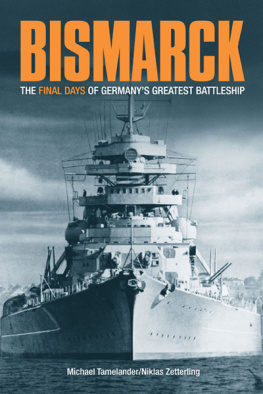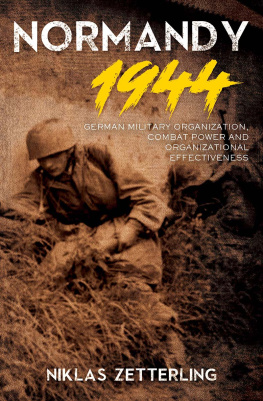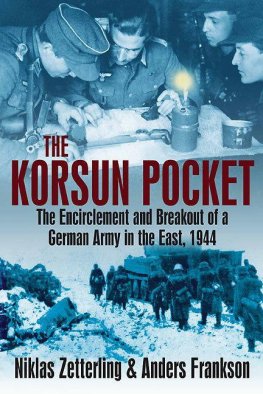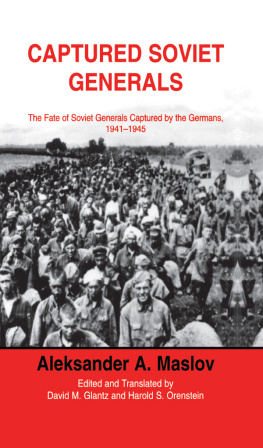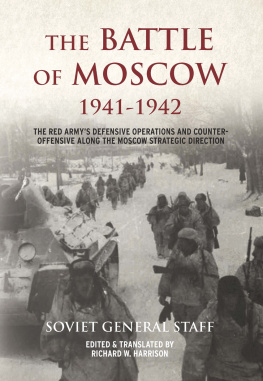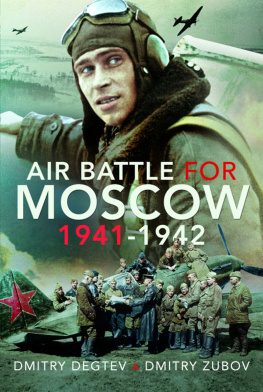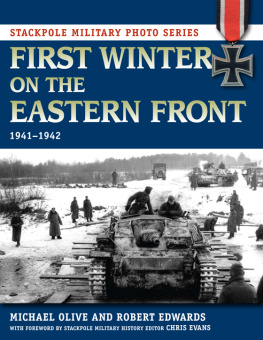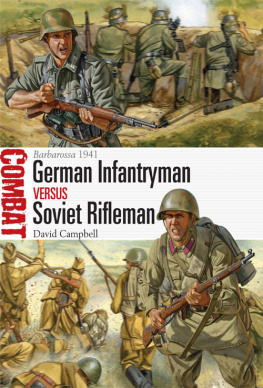The Drive on Moscow 1941
Operation Taifun and Germany's First Crisis of World War II
By Niklas Zetterling and Anders Frankson

CONTENTS

The German advance east during Operation Taifun went initially very good, but there were three factors that could slow them down: the weather, supply problems, and of course the Red Army. When the Germans began Operation Taifun, they knew they were in a race against the clock, but they did not know when their time would run out.
PREFACE
M any battles have been described as turning points in World War II, particularly El Alamein and Stalingrad. However, compared to many battles of the war, El Alamein was a small affair. The decisive effects of it are disputed, and in any case, it took place in an area of less than major strategic importance. Operations conducted in the Middle east in autumn 1942 may have been significant to British decision-makers, but involved only a very small share of the German armed forces and no US or Soviet formations.
Stalingrad is a better candidate, as far larger forces were engaged and from September 1942 to February 1943, the fighting in the city on the Volga attracted much attention from both Adolf Hitler and Josef Stalin. It can also be argued that prior to Stalingrad the Red Army seldom possessed the initiative, but afterward Soviet forces rarely allowed the Germans to dictate the course of events. Despite these compelling arguments, and the library of words written about this costly, well-known battle, the claims may have been exaggerated. We would argue that by the time fighting began at Stalingrad, the Germans had already lost the war. Admittedly, Hitler had launched a major summer campaign in eastern Ukraine in June 1942, but it was not large enough to knock the Soviet Union out of the conflict. Hence, the real turning point must be found earlier.
Launched in June 1941, Operation Barbarossa was a gamble. Hitler intended to subjugate the Soviet Union in six months. War planning, including long-term plans for the economy, was based on the assumption that the enemy in the east would be defeated. However, Hitler had seriously underestimated the Soviet capacity to wage war, and so German forces in the east were still battling against the Red Army in September 1941. The Germans felt they had to end the campaign before the winter came, preferably by a decisive victory at Moscow.
They made their final bid in late September/early October, when Operation Taifun (Typhoon) was launched. This was the long-awaited attack on Moscow, and the Germans initially recorded tremendeous success. However, after little more than a week, they were stuck in mud and the prize of Moscow slipped out of their grasp.
This was Hitlers first major defeat. Admittedly the Luftwaffe had failed to bring Britain to her knees in 1940, but Hitler was already devoting most of his energy to planning the attack on the Soviet Union while air battles raged over southern England. The invasion of the Soviet Union was his main project, and the failure at the gates of Moscow meant that his plans had been irrevocably thwarted.
The argument that Germany lacked the capacity to defeat the Soviet Union is plausible; however, Hitler and his entourage seem not to have held that opinion, and neither did many outside the Soviet Union. The German failure at Moscow made clear to many observers that Germany might not emerge victorious from the colossal struggle in the east.
The sheer scope of the battle of Moscow was exceptional. Both sides committed more than a million men to the battle; the Red Army also lost nearly a million men, but still the German forces were halted. This indicates the resources, and the importance, assigned to the battle by the two dictators. We hope the reader will enjoy our description and analysis of this important chapter in the history.
PROLOGUE
I n the evening of September 26, 1941 it dawned upon German army surgeon Hermann Trk that the day had been remarkable. He had not heard a single shot fired in anger, nor a single bursting shell or bomb. While he had of course experienced many such days previously in his life, they had been all too rare since June 22, when the 3rd Panzer Division had crossed the border between Germany and the Soviet Union.
As an army surgeon, Trk was not expected to participate in combat, but he was assigned to one of the divisions four motorized infantry battalions. This meant that he was seldom far from the action and quite often found himself in the front line assisting with the evacuation of wounded soldiers. During the past three months, the division had suffered 4,375 casualties, of which around three-quarters were wounded. The vast majority of these casualties had been incurred by the four infantry battalions and Trk had had to patch up many soldiers so they could be evacuated west to medical facilities.
As the 3rd Panzer Division had been one of the spearheads in Panzer Group 2, which was commanded by Colonel General Heinz Guderian, Trk had travelled many kilometers on Soviet roads. After crossing the border south of Brest-Litovsk, the division had dashed east. Bobruisk had fallen to the 3rd Panzer Division on June 28, after an advance of more than 400km. The fluid German operations continued and the 3rd Panzer Division crossed the Dnepr after hard fighting. Later, Trk and his comrades participated in the large encirclement operation near Kiev. This time, Trks division was one of the spearheads of the northern pincer.
The Kiev battle resulted in the encirclement of a huge Soviet force in September and eventually more than 600,000 Soviet soldiers marched into German captivity. However, with every passing day, the autumn drew nearer. The encirclement operation was hardly over when the 3rd Panzer Division began to regroup in a northeasterly direction. On September 25, Trk reached the area where the division would rest and refit. He was assigned suitable quarters in a village but he had to evacuate them after a few hours, as partisans were believed to be active there. Under cover of darkness, his unit moved to another village and spent most of September 26 on maintenance. To the great delight of many soldiers, a mailbag arrived from Germany and letters from parents, fiances, and other relatives were sources of joy for the soldiers.
Hopes for a long period of rest contrasted with rumors of an imminent major offensive. Trk was well aware that the vehicles were already badly worn and many of the replacement soldiers were not as well-trained and experienced as those they replaced. The division badly needed a period of rest, maintenance, and training. So far, no order had yet indicated an offensive. Trk had only heard rumors.
On September 26, Trk was finally informed: an offensive was indeed imminent. Few details were revealed, but he believed that the attack would be launched on October 1 and the objective would be Tula. He did not know how far away Tula was, but he hoped that the offensive would be over in two weeks. However, there were ominous signs. On the night of September 2627, the thermometer showed -3C. Nevertheless, preparations continued according to plan. Trk thought that as the Germans had been enormously successful thus far, another victory could be expected.
Trks unit remained stationed at the same location through September 28, enabling the chaplain to conduct a field service before regrouping on the following day. The vehicles had hardly begun to move when rain started to fall. After three months travelling on Russian roads, Trk knew full well how quickly rain could render them impassable, but the late season did not allow the Germans any further delays. They had to attack now or not at all.



